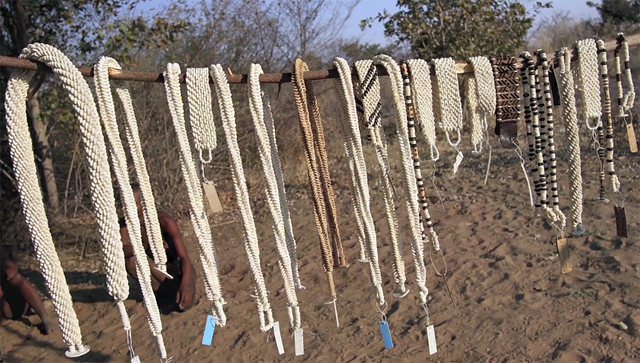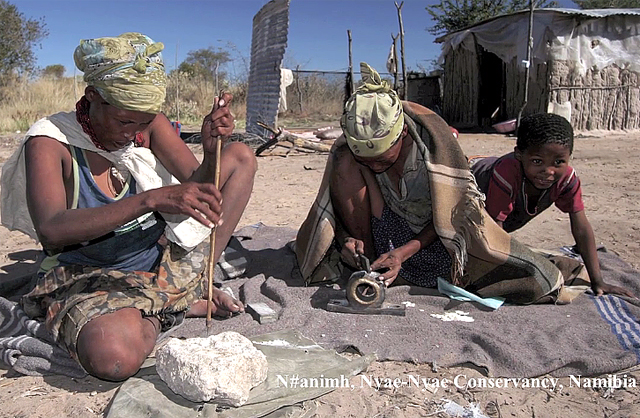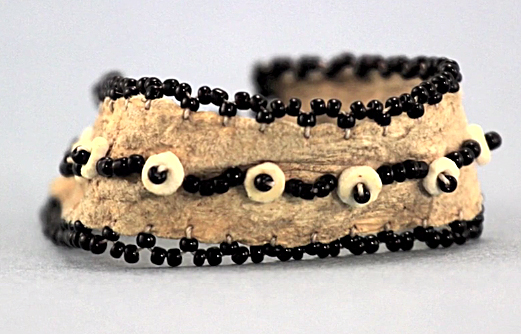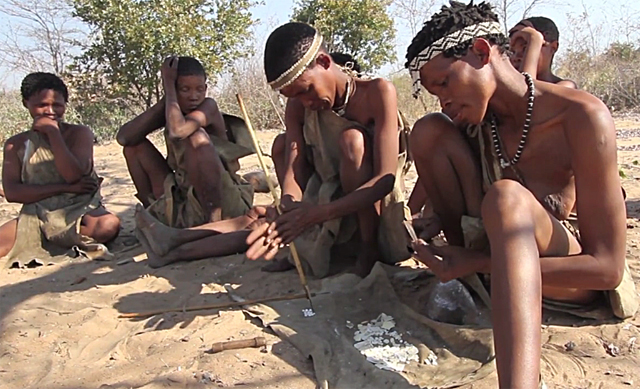Ju/’hoansi women have been making high-quality jewelry for ages, but over the past 30 years they have gradually developed their traditional craft into a viable, and profitable, export business. A news report last week from the New Era, a Namibian daily newspaper, displayed an understandable pride in the accomplishments of the women.

According to the reporter, the women sold more jewelry in 2016 than ever before. With their earnings, they are increasingly able to purchase outside goods and products for their families that would otherwise be unobtainable. While the women in the Nyae Nyae Conservancy have made jewelry out of bits of ostrich eggshells for 30 years now, the newspaper indicated that they have been making and wearing it for centuries. The difference is that the women have changed and updated their designs and added modern twists.
Major NGOs such as the Nyae Nyae Development Foundation of Namibia (NNDFN) and the Omba Arts Trust have supported the women by linking them to regional, national, and international buyers. The jewelry is being worn by Namibians and increasingly by Europeans. The jewelry makers are hoping that their sales will increase in 2017 to half a million dollars.

Lara Diez, from the NNDFN, told the New Era that increasing the cash sales has not been the only goal for the Ju/’hoansi. She identified such other benefits from the growing sales as spreading the fame of the traditional jewelry and increasing appreciation for the intrinsic beauty of the pieces. She also said that the jewelry business was an important way to help “empower communities to be able to take care of themselves and not depend on handouts.”
It is interesting to note that the Ju/’hoansi women today are committed to making their jewelry at least partly out of the traditional source material—ostrich eggshells. Anthropologist Polly Wiessner (1984) noted that when she did her research among several San societies from 1973 to 1977, headbands, the traditional form of jewelry they wore, were being made by the women out of beads which they were able to purchase at a couple local stores. In earlier years, before the availability of manufactured beads, they had used bits of ostrich eggshells to make them. The beads were then used for making jewelry, particularly headbands, Wiessner wrote.

In the 1970s, the headbands helped the Ju/’hoansi preserve their peacefulness. They were carefully sewed using a variety of patterns that were used with several different background designs. Since making them consumed a considerable amount of time, the headbands were among their most prized possessions. The Ju/’hoansi associated their headbands with beauty, plenty, festivity, and happiness, and the people told Wiessner that one should wear them “when one’s heart soars.”
Even though they were (and presumably still are) very personal and prized, a major function of the headband was as an item of exchange, to be given to another after one has enjoyed it for a few months. After a headband had changed hands several times and the threads were becoming worn, they would be unraveled so the beads could be woven again into another headband. Wiessner (1982) explored in detail the importance of gift exchanges of bead headbands for fostering Ju/’hoansi peacefulness.

The ideal headband consisted of a design that wandered along a background and reminded the wearer of the way a person should walk quietly back to camp through the bush. The headband design often suggested, for instance, the desired modesty of the successful hunter when he returned to camp and left his kill at the edge of the clearing without speaking a word of self-congratulation to anyone. It should evoke the discretion of interpersonal relations which, ideally, maintained social harmony.
Wiessner (1984) wrote that when she asked the Ju/’hoansi women why they made their headband jewelry so beautiful, 77 percent replied that they did so to promote reciprocal relations, 48 percent did so for self-satisfaction, and 88 percent gave as their reason a desire to impress the men.
However, while the women were clearly aware of the positive values that everyone attached to giving and receiving beautiful, hand-made jewelry, they also were conscious of the possible negative implications of manipulating people and arousing jealousies about the prized possessions. Conversations among the people about their bead-work were usually positive in tone, a contrast to their normal, everyday style of complaining and refraining from complimenting each other.

Thus, the headbands represented enduring social commitments that should be above the frequent bickering about minor issues that plagued their camps. Furthermore, the headband jewelry was useful to the Ju/’hoansi for defining personal identity as well as for supporting interpersonal relationships. Designs were shared across a wide expanse of territory, which allowed the people to express their affiliations with kin in distant as well as in nearby settlements.
But to judge by last week’s news report, those cultural associations have weakened. The jewelry makers of the 1970s may have admired new designs, but Wiessner (1984) made it clear that they resisted incorporating changes into their own work. It was important for them to be able to tell who had designed the pieces. “We do not want to copy these designs [by outsiders] as we do not know the people who made them,” they told her (p.211). The Ju/’hoansi women have evidently become far more flexible over the last four decades, as they now make changes that will help them sell their products. It is not clear, however, if the jewelry still plays much of a role in helping them remain a peaceful society.